Sales = gross income, and profits are net income:
Still down:
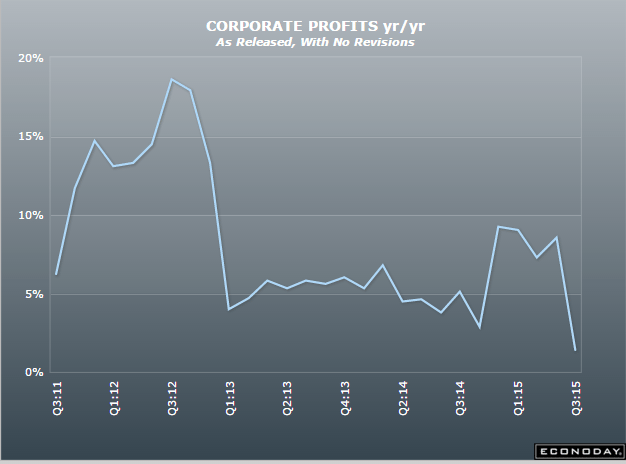
Adjusted for inflation housing prices are about where they were 10 years ago:
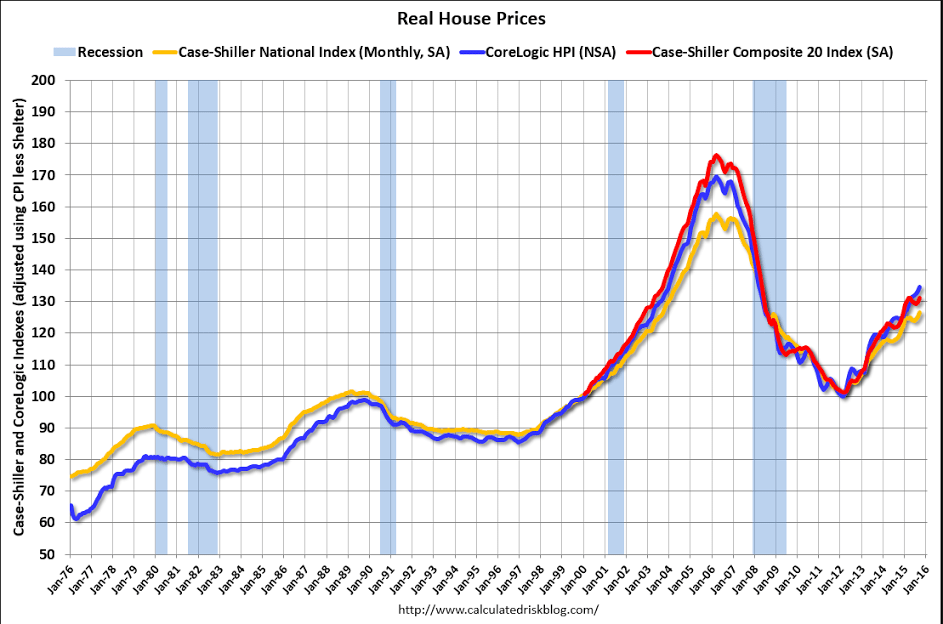

Output was revised up, but mainly due to growing unsold inventory, with other spending revised lower and showing more deceleration than the first release:
GDP
Highlights
Third-quarter GDP is revised to an annualized plus 2.1 percent, up 6 tenths from the initial estimate but showing less strength by the consumer with final sales now at plus 2.7 from plus 3.0 percent. Higher inventories are a big factor in the upward revision, subtracting 6 tenths from GDP vs an initial 1.4 percent subtraction.
Net exports pulled GDP down by 2 tenths vs only a small negative effect in the first estimate. Exports rose only 0.9 percent in the quarter, down 1 percentage point from the initial reading. Readings on residential investment, adding 2 tenths to GDP, and nonresidential fixed investment, adding 3 tenths, are little changed.
Turning back to the consumer, personal consumption expenditures are revised to plus 3.0 percent, down 2 tenths from the initial estimate and reflecting less strength for durable goods and also services on lower spending for communications and natural gas.
The gain in inventories is not a positive for the fourth quarter, posing headwinds for businesses which may limit production and employment to pull down their inventories. Still, the readings on the consumer are a positive and a reminder that the nation’s economy is being driven by domestic demand. Other details include a tame plus 1.3 percent rise in the GDP price index, up 1 tenth from the initial reading.
Note the decelration over the last year as oil prices and capital expenditure collapsed:
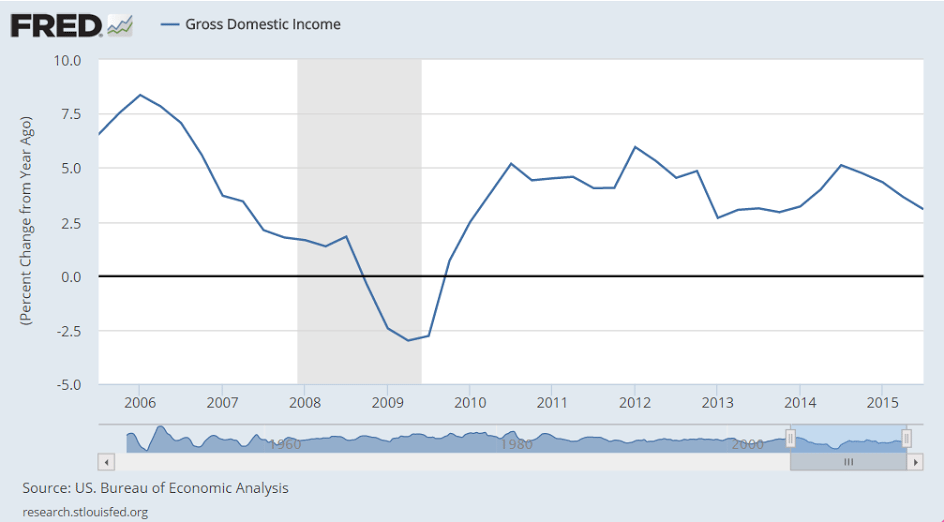
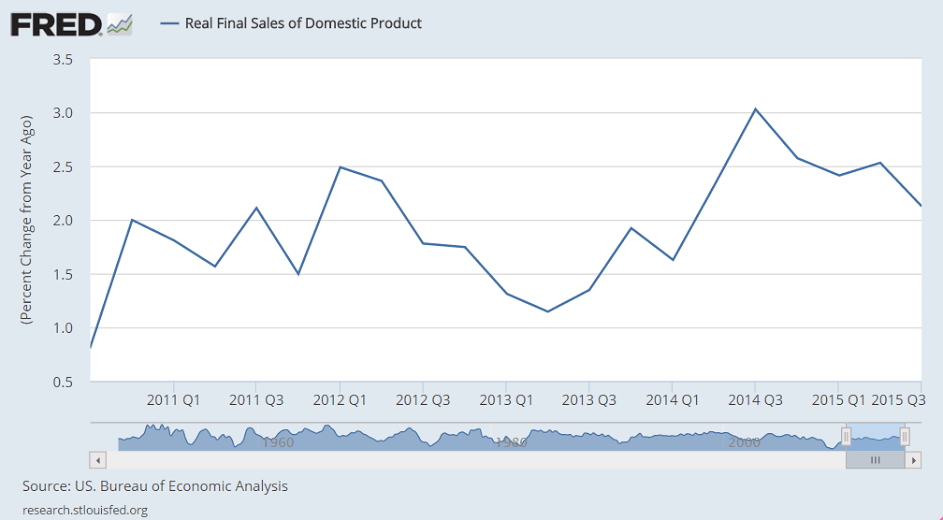
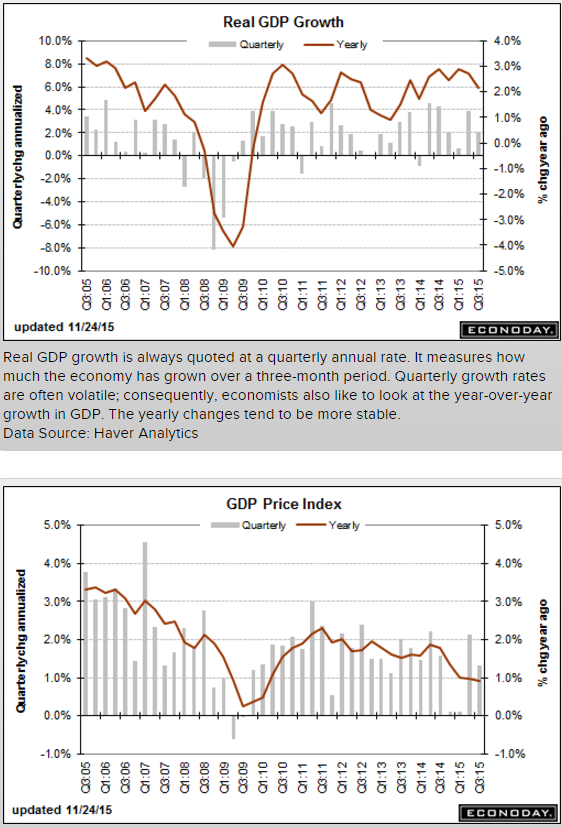
Collapsing?
Consumer Confidence
Highlights
Lack of confidence in the outlook for the jobs market sank the consumer confidence index in November, which fell to 90.4 vs a revised 99.1 in October. The November reading is far under expectations and is the lowest since September last year. Expectations, one of two main components in this report, fell more than 10 points to 78.6 which is the lowest reading since February last year. The employment subcomponent here shows fewer consumers seeing jobs opening up six months from now and more seeing fewer jobs ahead.
The present situation component shows less weakness, down 6.5 points to 108.1 which is the lowest reading since only July. Here the employment subcomponent also shows weakness but nothing dramatic, with 26.2 percent saying jobs are hard to get which is up from October’s 24.6 percent but still respectable. But those describing jobs as currently plentiful showed more noticeable deterioration, at 19.9 percent vs October’s 22.7 percent.
A plus in the report is a jump in buying plans for autos, at 12.4 percent vs October’s 9.8 percent in a reading that hints at renewed acceleration for the motor vehicle component of the government’s retail sales report. A negative is a dip in home buying plans, to 5.6 percent from 6.2 percent. Other readings include a 1 tenth dip in inflation expectations to 5.0 percent which, for this particular reading, is actually subdued but nothing dramatic.
But the decline in job expectations is dramatic and raises the question whether global effects, which have been negative for the U.S., are beginning to weigh on the American consumer — which would not be a positive for the holiday spending outlook.
Corporate Profits
Highlights
Corporate profits in the third quarter came in at a revised $1.786 trillion, up a year-on-year 1.4 percent. Profits are after tax without inventory valuation or capital consumption adjustments.
Richmond Fed Manufacturing Index
Highlights
Early indications for the November factory sector are soft right now after Richmond Fed reports a much lower-than-expected minus 3 headline for its manufacturing index. Order data are very negative with new orders at minus 6, down from zero in October, and backlog orders at minus 16 for a 9-point deterioration. Shipments are also in contraction, at minus 2, with the workweek at minus 3. Employment, at zero, shows no monthly change but the declines for backlog orders and the workweek don’t point to new demand for workers. Price data are subdued but do show some constructive upward pressure.
This report along with Empire State, as well as yesterday’s manufacturing PMI, are pointing to a downbeat month for the factory sector which is being held down by weak foreign demand, as evidenced in the decline for goods exports in this morning’s advance release of international trade data.
International trade in goods
Highlights
The nation’s trade gap in goods came in at a lower-than-expected deficit of $58.4 billion in October vs $59.2 billion in September. Though the month-to-month comparison points to improvement for the trade deficit, the details are not positive with exports down 2.6 percent and imports, in a sign perhaps of softening domestic demand, down 2.1 percent and following weakness also in September. Weak categories for imports include foods/feeds/beverages, industrial supplies and also capital goods as well as consumer goods with the latter hinting at weak business expectations for the holidays. Export categories showing weakness include foods/feeds/beverages and also industrial supplies.
Part of the Fed’s mandate is to hit it’s 2% inflation target:
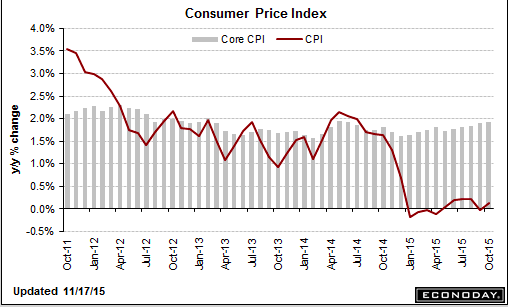
Still at recession type levels:
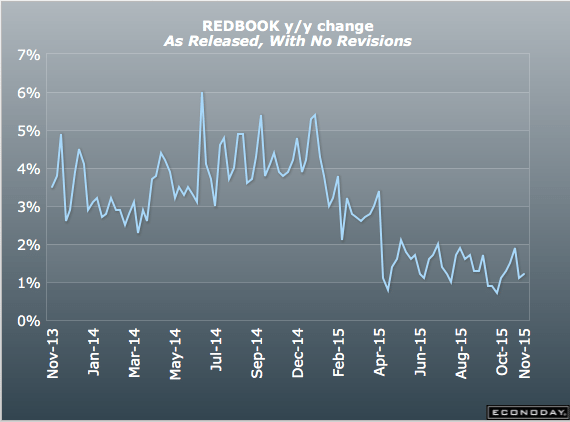
This is also what recession looks like:
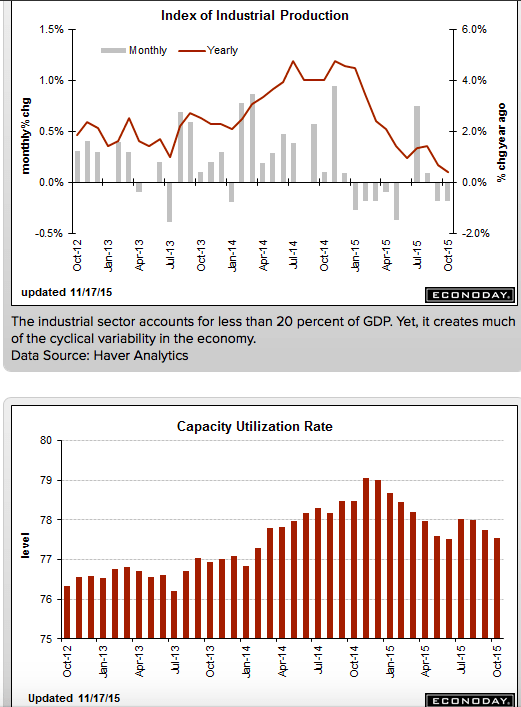
The anointed ‘driver of the economy’ continues to falter as previously discussed:
Housing Market Index
Highlights
The housing market index from the nation’s home builders shows weakness, at 62 for November and missing the Econoday consensus by 2 points. And compared to a revised October, the index is down 3 points. Yet readings in the report, though slowing, remain solid and one important detail is favorable.
Of the report’s three components, future sales are down a sizable 5 points but the level is still in the seventies, exactly at 70. Present sales, which is the most heavily weighted component, fell 3 points to 67, also still a strong level.
The positive in the report is a 1 point rise in traffic, a component which, at 48 in the latest report, has been lagging badly but is getting closer to the breakeven 50 mark. Weakness in this reading has been reflecting lack of first-time buyers in the market.
Turning to regional data, the highest composite score goes to the West, at an enormously strong 77, followed by the South, at 62. Two less watched regions for new homes, the Midwest and North, trail at 59 and 52.
There are positives in this report but the decline in both future and present sales is a reminder that both starts and permits for single-family homes have been slowing. Despite the rise in traffic, this report probably pulls back the housing outlook by a degree.
October 2015 Sea Container Counts Continue to Show Trade Recession Continues
By Steven Hansen
The data for this series continues to be in contraction. The year-to-date volumes are contracting for both exports and imports. The trade sector remains in a recession.
Federal agencies don’t need ‘capital’ to function.
This is simply unspent income that reduces aggregate demand:
FHA Meets Minimum Reserve Requirement for First Time Since 2009
(WSJ) — The Federal Housing Administration, which backs low-down-payment mortgages popular with first-time home buyers, said its insurance fund’s net worth at the end of September was $23.8 billion, up from a year-earlier level of $4.8 billion. Its capital reserve ratio, which by law is required to stay above 2%, rose to 2.07%, the first time it met the threshold since the start of the agency’s 2009 fiscal year. With the private subprime-mortgage market largely gone, the agency offers some of the easiest terms available, letting borrowers with a credit score as low as 580 make a down payment of as little as 3.5%.
Passenger car registrations: +8.2% over ten months; +2.9% in October
(ACEA) — In October 2015, the EU passenger car market continued its upward trend, despite a slower rate of increase (+2.9%), marking the 26th consecutive month of growth. Demand for new passenger cars saw momentum slowing down in all major markets. Registrations in Italy (+8.6%), Spain (+5.2%), Germany (+1.1%) and France (+1.0%) kept growing, even though less strong than in past months, while the UK market declined in October (-1.1%). Across the region, new passenger car registrations totalled 1,104,868 units, also supported by growth in the EU’s new member states (EU-12).
Can’t admit fiscal works and monetary doesn’t:
Abe to call for supplementary budget topping 3tn yen
(Nikkei) — Prime Minister Shinzo Abe will direct the Japanese government to put together a supplementary budget totaling more than 3 trillion yen ($24.2 billion) next week to help shore up a flagging economy. The government is set to compile measures to cope with the Trans-Pacific Partnership trade pact on Nov. 25 and steps for promoting active civic engagement on Nov. 26, with both to be incorporated into the extra budget for fiscal 2015. The prime minister declined to characterize the supplementary budget as a stimulus measure, since doing so could be seen as admitting defeat on Abenomics.
Capital spending delays took toll on July-September GDP
(Nikkei) —Weak capital investment led Japan’s economy to shrink by an annualized 0.8% in the three months ended September. A 1.3% drop in capital investment was the main cause of the decline. Corporations had planned to invest a good deal this fiscal year, though the follow-through has been lacking. Machinery orders, which typically lead capital investment by three to six months, slipped 10% for the July-September quarter. But if the outlook for economic growth overseas remains hazy, more companies could put investment on hold.
More deflation news here:
Nothing good here, and of course sales = income, so lower sales = lower incomes.
Also, the boost to prior months from car sales looks like it’s fading:
Retail Sales
Highlights
Retail sales slowed in October but fundamentally remain solid. Sales rose only 0.1 percent, 2 tenths under the Econoday consensus. But when excluding vehicles, which slipped back after surging in prior months, and when also excluding gasoline stations, where sales once again fell on price weakness, core sales rose a respectable 0.3 percent which hits the consensus.
And there are solid gains including for housing-related components of furniture & home furnishings and building materials & garden equipment. Nonstore retailers also show a strong gain as do restaurants.
Aside from vehicles and gas, other areas that declined are electronics & appliance stores, grocery stores, and the big category of general merchandise sales. Declines in the latter may be related to import-price effects which are deflating sales. A positive, however, is a gain for department stores which are a subset of general merchandise. Apparel sales, which are definitely being held down by import prices, were unchanged following two small declines.
Year-on-year rates really tell the story especially a respectable plus 4.1 percent rate for sales excluding gasoline stations, a component that is down 20.1 percent and has been badly skewing total sales all year. Total sales are up only 1.7 percent.
The headline is weak and year-on-year rates did ease off, including for core ex-auto ex-gas to plus 3.5 from 3.8 percent, but this report is better than it looks, showing underlying strength that shouldn’t scale down expectations for a December FOMC rate hike.
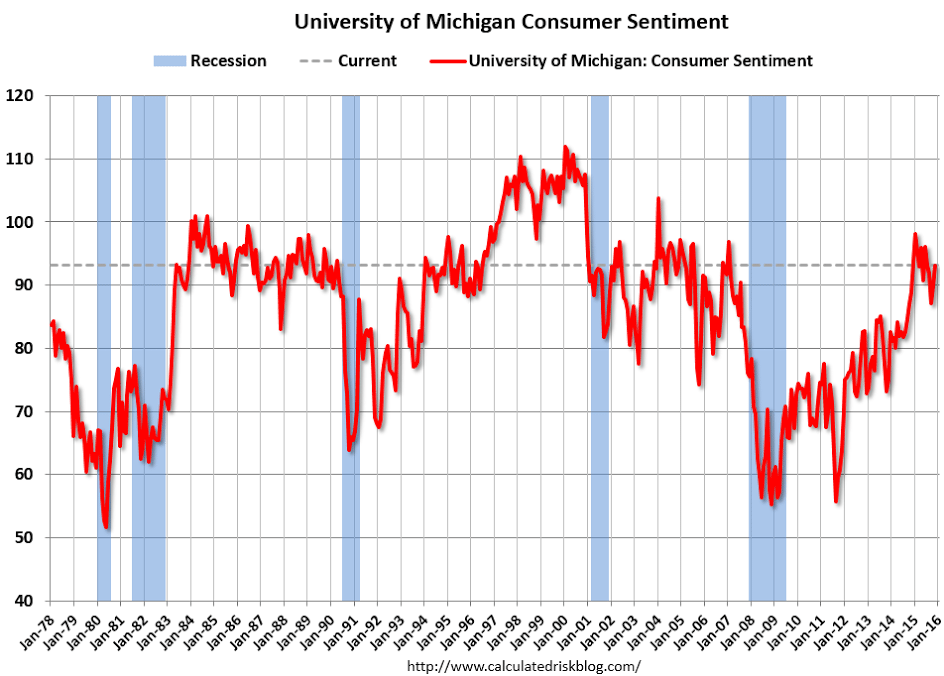
Looks to me like the excess inventory situation has gone from bad to worse, as sales continue to lag output:
MANUFACTURING AND TRADE INVENTORIES AND SALES September 2015 Sales.
The U.S. Census Bureau announced today that the combined value of distributive trade sales and manufacturers’ shipments for September, adjusted for seasonal and trading-day differences but not for price changes, was estimated at $1,320.3 billion, virtually unchanged (±0.2%)* from August 2015, but was down 2.8 percent (±0.4%) from September 2014.
Inventories.
Manufacturers’ and trade inventories, adjusted for seasonal variations but not for price changes, were estimated at an end-of-month level of $1,817.5 billion, up 0.3 percent (±0.1%) from August 2015 and were up 2.5 percent (±0.5%) from September 2014. Inventories/Sales Ratio.
The total business inventories/sales ratio based on seasonally adjusted data at the end of September was 1.38. The September 2014 ratio was 1.31.
This shows how private sector credit deceleration is associated with recessions. It’s about the need for those spending more than their incomes to offset those spending less than their incomes. And most often private sector deficit spending decelerates some time after public sector deficit spending decelerates and fails to provide the income and net financial assets that supports private sector deficit spending.
United States : JOLTS
Highlights
In a positive sign for labor demand, job openings in the JOLTS report popped back up in September, to 5.526 million from a revised 5.377 million in August. Openings peaked in July at a recovery best 5.668 million. High job demand will absorb yet more slack from what is a dwindling supply of available labor, in what could precede wage inflation and become a major concern for Fed policy makers. But in a contrasting indication of worker hesitance, confidence in the strength of the labor market may be limited based on the report’s quits rate which remains stubbornly low, unchanged for a sixth month at 1.9 percent.
Along with most indicators, this one turned south as oil capex collapsed:
Update: Framing Lumber Prices down Sharply Year-over-year
Here is another graph on framing lumber prices. Early in 2013 lumber prices came close to the housing bubble highs.
The price increases in early 2013 were due to a surge in demand (more housing starts) and supply constraints (framing lumber suppliers were working to bring more capacity online).
Prices didn’t increase as much early in 2014 (more supply, smaller “surge” in demand).
In 2015, even with the pickup in U.S. housing starts, prices are down year-over-year. Note: Multifamily starts do not use as much lumber as single family starts, and there was a surge in multi-family starts.
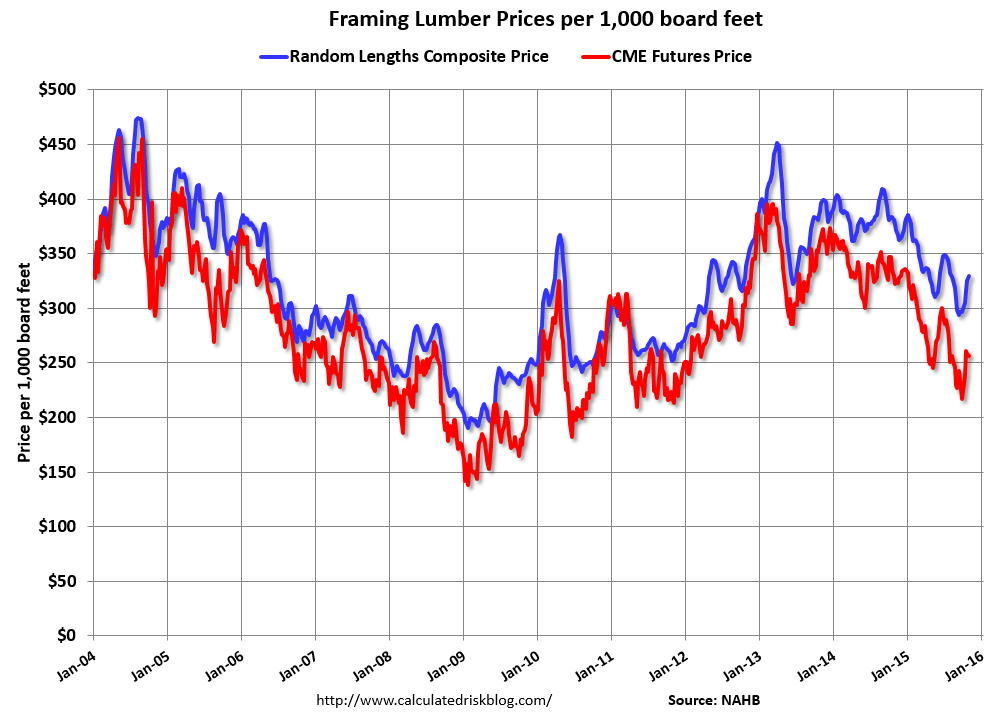
There were hopes that the last tic up was the beginning of a reversal but now seems the downtrend since the oil capex collapse may still be in progress:


The deflationary forces continue:
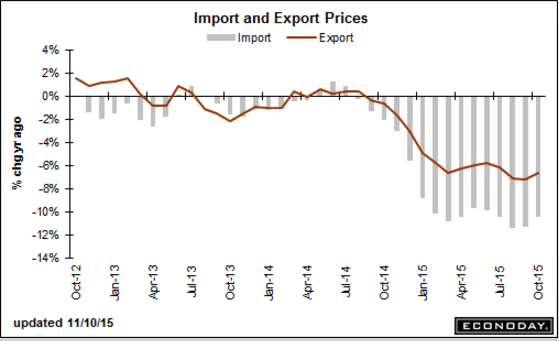
No sign of consumer strength here:
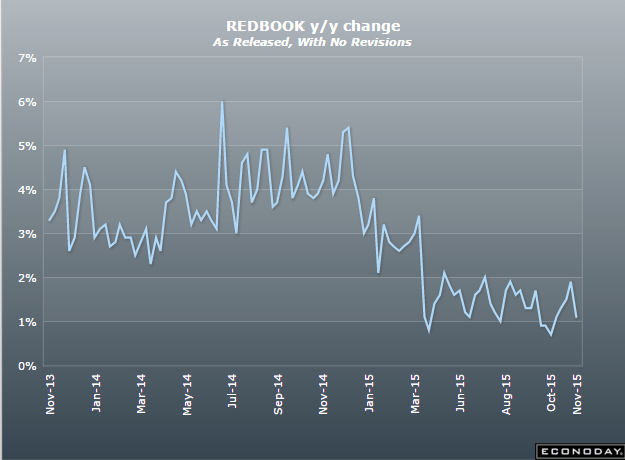
Inventories remain high going into Q4:
Wholesale Trade
Highlights
Wholesale inventories rose 0.5 percent in September following an upward revised 0.3 percent gain in August. The September build appears to be intentional based on a 0.5 percent rise in September sales that keeps the stock-to-sales ratio for wholesalers unchanged at 1.31.
Inventories of autos rose 2.3 percent as wholesalers try to keep up with what is very strong retail demand for autos. Excluding autos, the stock-to-sales wholesale ratio is unchanged at 1.27.
Inventory draws reflecting gains in sales include computer equipment, electrical goods, and apparel. Wholesale inventories of furniture rose on a swing lower for sales.
Inventories in general are heavy and businesses, waiting for a pick up in sales, are being careful to keep them in check. Today’s results are in line with Commerce Department assumptions and should have little bearing on third-quarter GDP revisions. Watch Friday for the business inventories report which will include data from the retail sector.
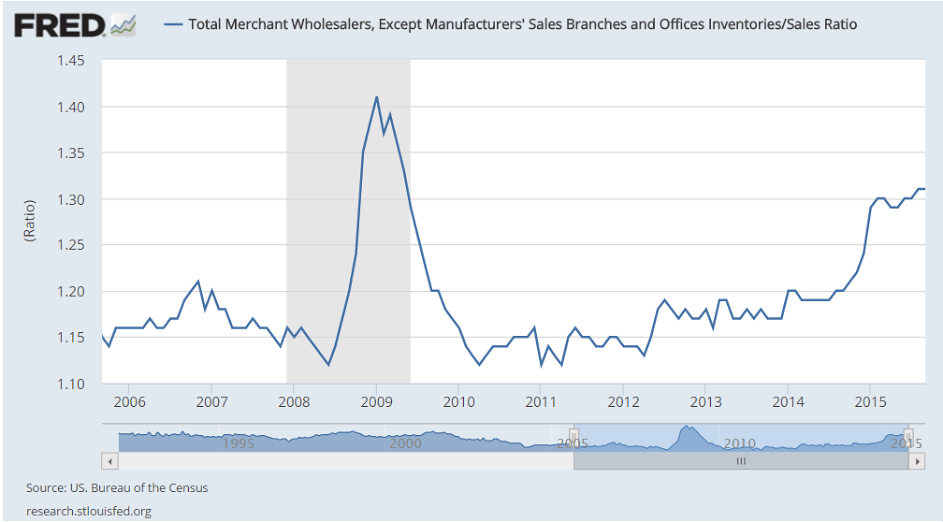
Sales looking like recession:
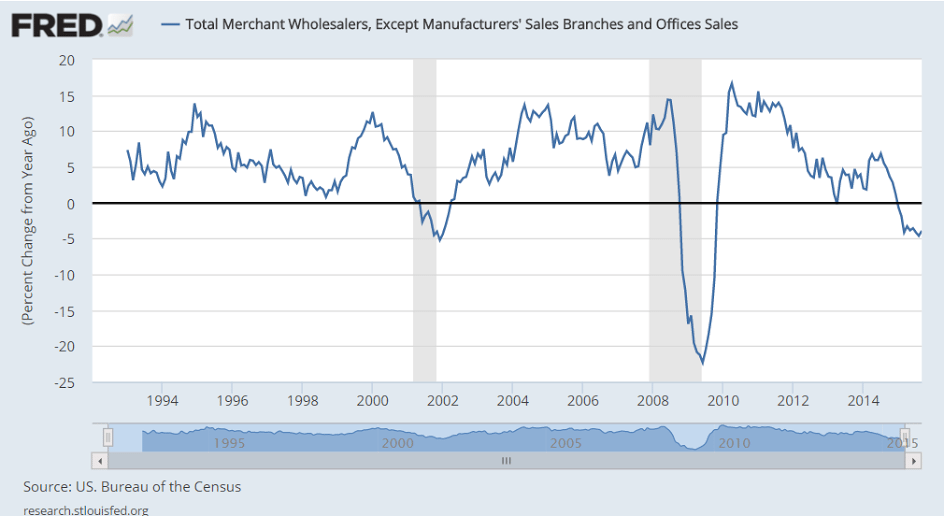
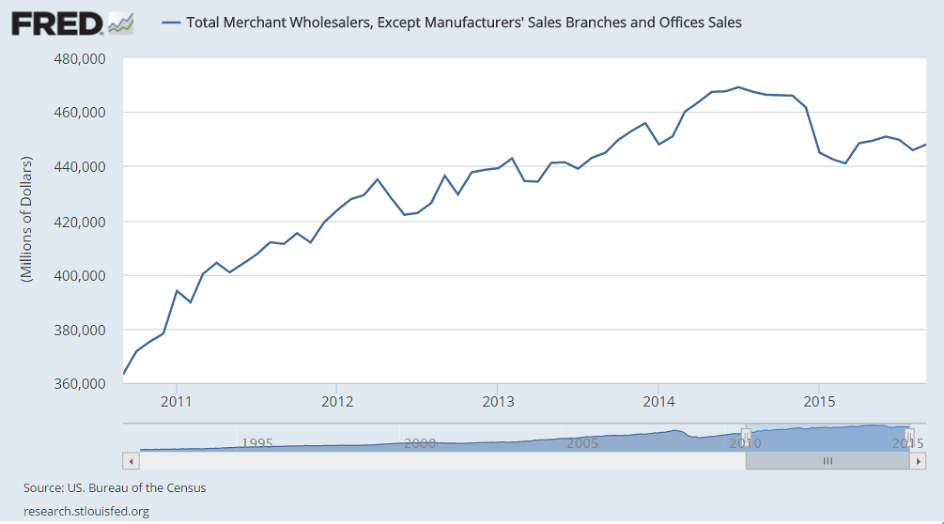
Autos are just holding their own:
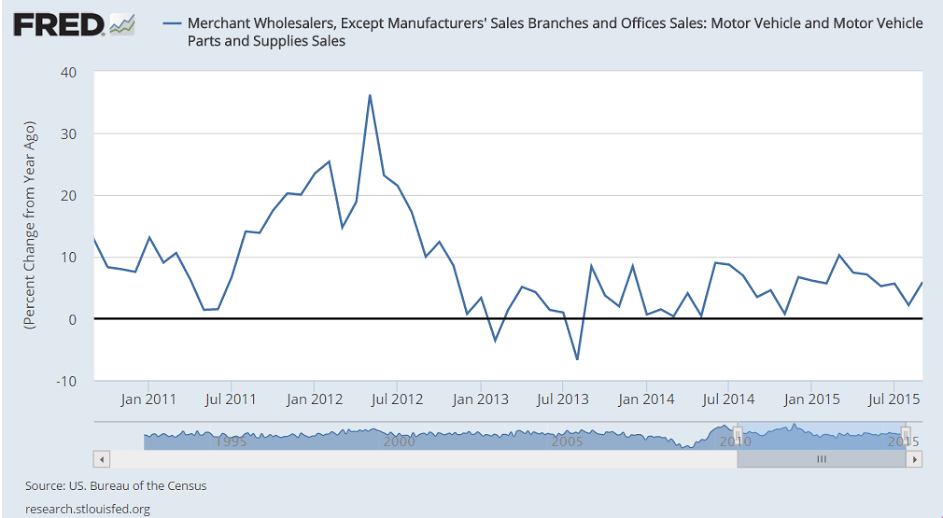
Consumer Credit
Highlights
In a record report, consumer credit data are strongly confirming the strength of the consumer. Credit outstanding surged $28.9 billion in September for the largest gain in the history of the series which goes back to 1941. Nonrevolving credit, in part reflecting vehicle financing and also student loans, rose $22.2 billion. Revolving credit, reflecting a rise in credit-card debt, jumped $6.7 billion to extend an emerging run of strength that suggests consumers are now less reluctant to run up their credit cards which, for retailers certainly, is a good omen for the holidays.
Hard to detect anything happening here except some volatility and maybe consumers borrowing more in response to low personal income growth?
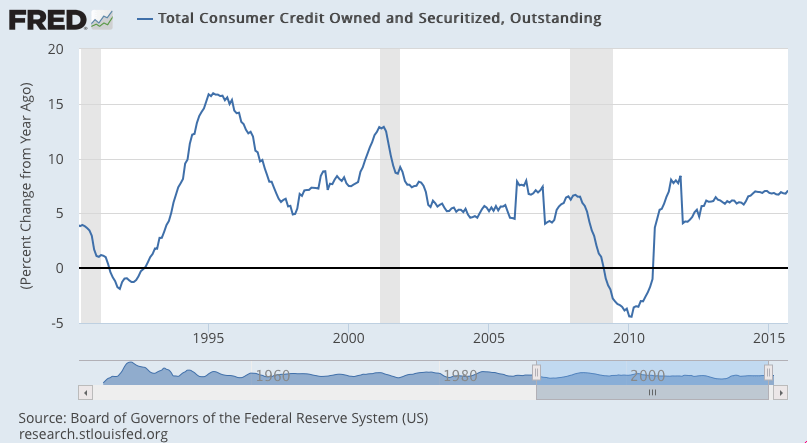
Fed rate hikes are meant to slow credit growth.
I don’t see any credit growth they’d want to be slowing?
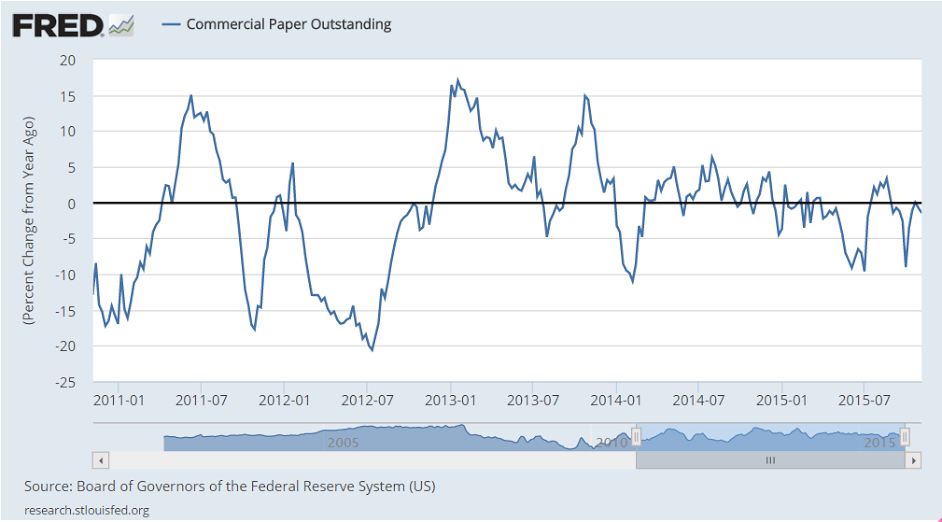
This has recently flattened at grow rates associated with the last recession:

Rail Week Ending 31 October 2015: Monthly Data Now Contracting 4.3% Year-over-Year
Week 43 of 2015 shows same week total rail traffic (from same week one year ago) and monthly total rail traffic (from same month one year ago) declined according to the Association of American Railroads (AAR) traffic data. Intermodal traffic contracted year-over-year, which accounts for approximately half of movements. and weekly railcar counts continued in contraction. October 2015 is down 4.3% over October 2014.
Yes, this earnings measure did pop up some, but way behind prior cycles and just a one month move at this point. The 2014 move they were worried about reversed itself before it got anywhere near ‘danger’ levels, whatever that actually means:
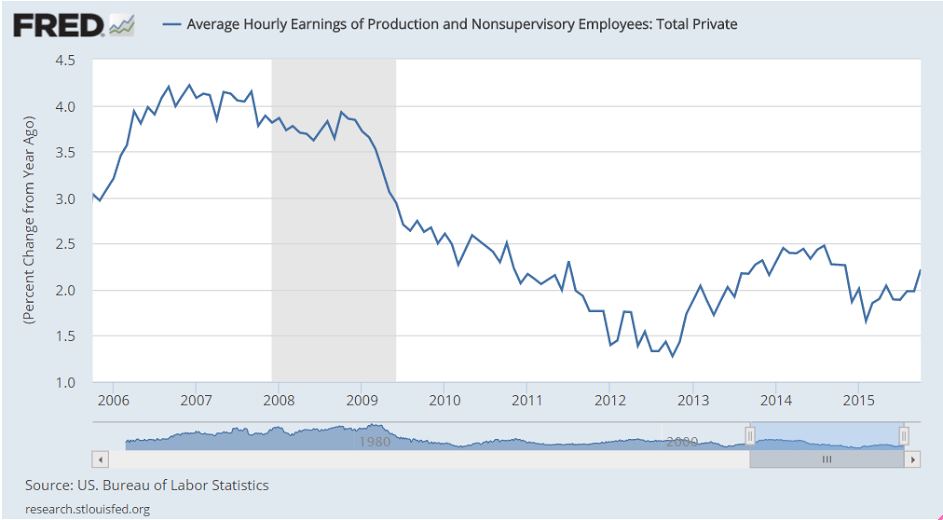
Again, a one month move that could just as easily reverse next month, and in any case far from posing any kind of problem to ‘inflation’ or employment (the Fed’s mandates):
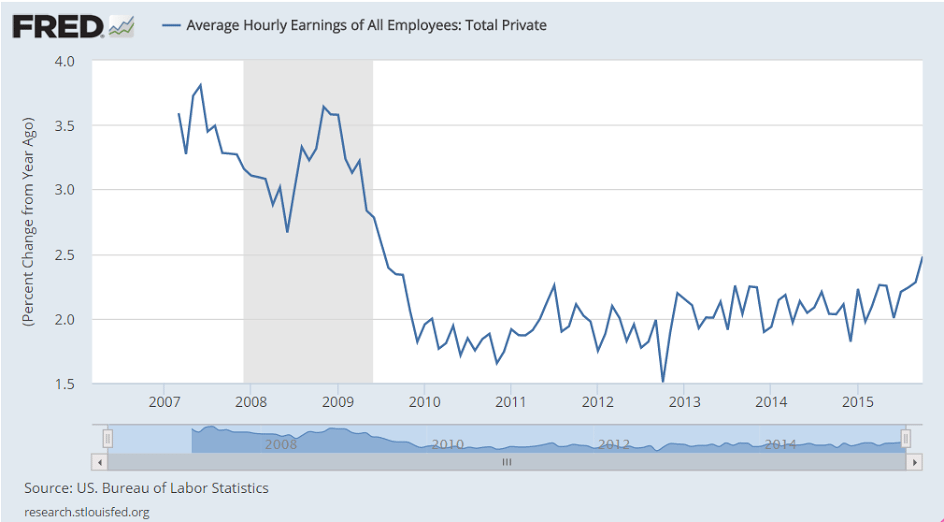
And this is from the GDP report:
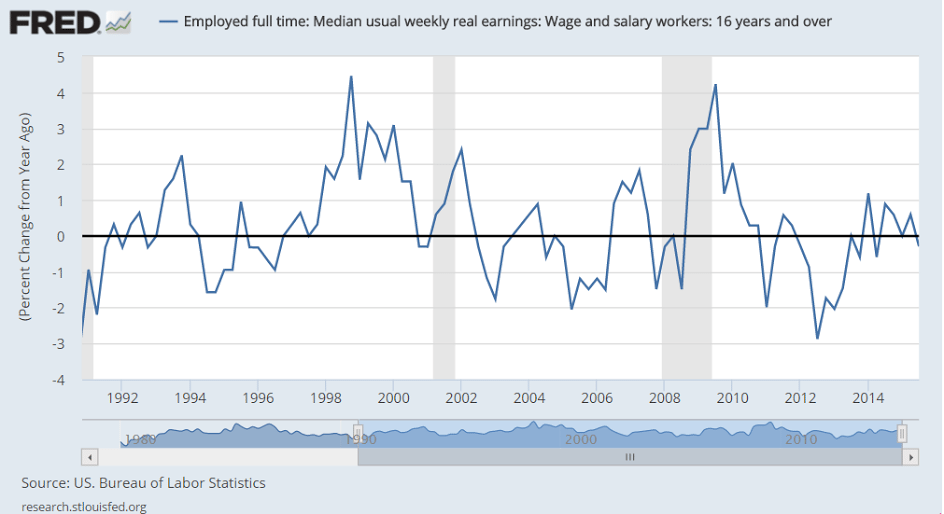
This was just starting to begin to recover when the oil price collapse bent the curve downward:
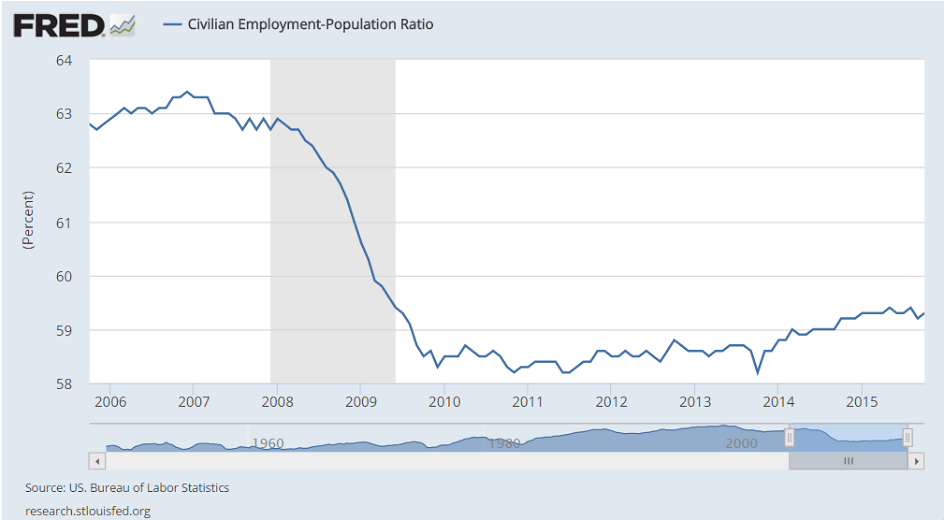
Down a bit but still trending higher since the oil price collapse:
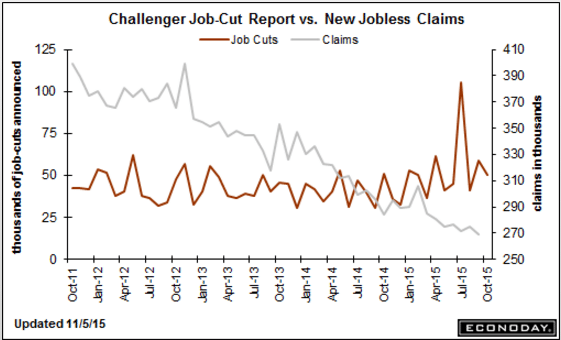
Seems she still doesn’t realize negative rates are just another tax:
FED’S YELLEN: IF ECONOMY SIGNIFICANTLY DETERIORATED, NEGATIVE RATES AND OTHER TOOLS WOULD BE ON THE TABLE
This implies the rest of Saudi pricing remains the same from November, when discounts to benchmarks were substantially increased.
In general, discounts have been increased over the last few months:
Saudi Arabia, the world’s largest oil exporter, raised pricing for December sales of all its crude grades to Asia as profit for refiners improved in the country’s largest market. OPEC’s biggest producer cut its monthly pricing for all blends for buyers in the U.S.
State-owned Saudi Arabian Oil Co. increased its official selling price for Arab Light grade crude by 30 cents to a discount of $1.30 below the regional benchmark, the company said in an e-mailed statement. That beat expectations for a 25-cent increase, according to the median estimate of of six refiners and traders surveyed by Bloomberg this week.
The chart shows that discounts were set at the wides back in Feb, then relaxed some, and are now generally back towards the wides, indicating the desire to keep prices down:
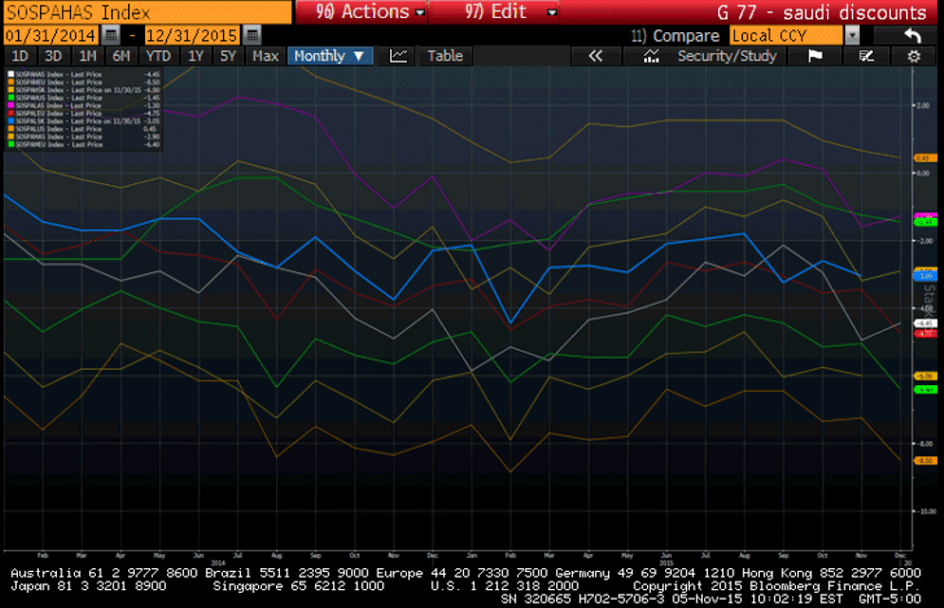
German Factory Orders Unexpectedly Decline for Third Month
Nov 5 (Bloomberg) — German factory orders, adjusted for seasonal swings and inflation, fell 1.7 percent in September from August, when they dropped 1.8 percent. Orders declined 1 percent from a year earlier. Factory orders dropped 2.8 percent in the third quarter from the previous one. Demand from within the country increased 0.3 percent and was up 0.9 percent for the euro area. Non-euro-area orders fell 8.6 percent in the July-to-September period. In September, orders for investment goods from the euro area fell 12.8 percent, reflecting a drop in demand for big-ticket items. Excluding bulk orders, demand fell 0.4 percent.
Maersk Line to Cut 4,000 Jobs as Market Deteriorates
Nov 4 (WSJ) — Danish conglomerate A.P. Møller-Maersk A/S saidWednesday its Maersk Line container-shipping unit would cut 4,000 jobs from its land-based staff of 23,000. It is also canceling options to buy six Triple-E vessels. Maersk said it would also push back plans to purchase eight slightly smaller vessels. The conglomerate said it would cut its annual administration costs by $250 million over the next two years and would cancel 35 scheduled voyages in the fourth quarter. That is on top of four regularly scheduled sailings it canceled earlier in the year.
Sliding Canton Fair orders signal poor outlook for producers
Nov 5 (Nikkei) — Foreign orders at China’s leading trade show slipped 7.4%. Chinese producers and overseas buyers at this year’s autumn session of the China Import and Export Fair, better known as the Canton Fair, signed contracts for $27 billion in goods, down from $29.1 billion last fall. Traffic from Europe shrank more than 10% from last fall amid the continent’s hazy economic outlook. The total value of contracts inked at the fair declined from the year-earlier figure for the eighth straight session, drawing alarmingly close to the $26.2 billion total from spring 2009.
So when the Saudis widened their discounts on October 5 it looked to me like they were inducing a downward price spiral that would continue until either they altered pricing or their output increased to full capacity so they couldn’t sell any more at those discounts. So far neither has happened:
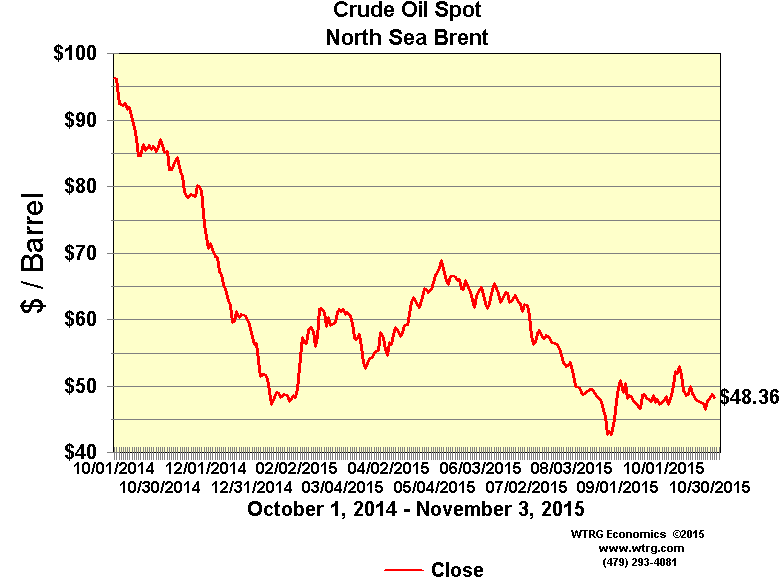
Fundamentally the euro also looks very strong to me, with a large and rising trade surplus vs a rising trade deficit for the US, and negative rates and QE ultimately further remove euro income from the economy likewise fundamentally making it stronger, while higher rates ultimately do the reverse. And deflation *is* a stronger currency, and inflation *is* a weaker currency. Yet the euro has most recently been moving lower on threats from Draghi of lower rates and more QE. So portfolio type selling, until exhausted, continues to dominate even as the fundamentals continue to improve. And there is only one portfolio that can sell indefinitely, and that’s the ECB. And I’ve been assured by all I’ve spoken to that the ECB is not selling euro:
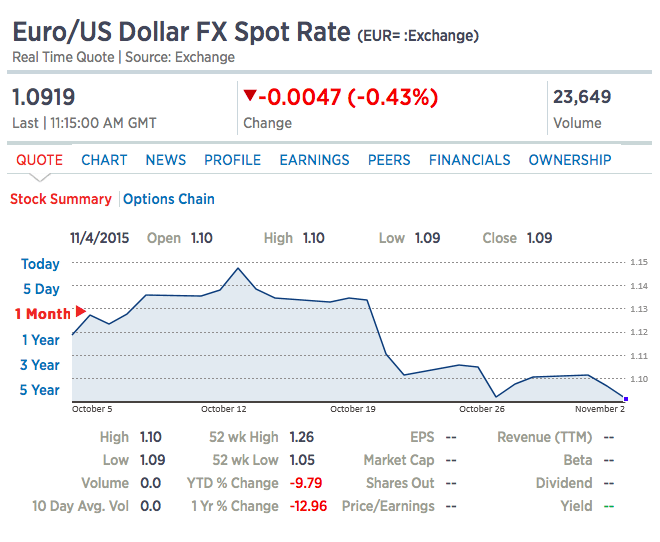
It’s not just OPEC, but most entities with oil related income seem to have only partially cut back on spending as prices collapsed, perhaps ‘betting’ on a price recovery. This includes US states with oil and gas revenues, oil companies, and individuals collecting royalty checks. So seems there’s lots more to go:
OPEC Moves to Rein in Costs Amid Oil Price Slump
By Benoit Faucon
Nov 3 (WSJ) — The Organization of the Petroleum Exporting Countries is moving to rein in costs as its members struggle to pay their dues amid a protracted period of low oil prices, OPEC officials said. The producers’ group has delayed new hires, reduced training sessions for staff and scaled back travel. Staff-level OPEC officials are meeting this week in Vienna to discuss adjusting spending at the secretariat, the organization’s central body, officials said. Other topics over three days of talks ending Wednesday include the group’s long-term strategy report, they said.
ECB will do what is needed to keep inflation target on track: Draghi
By Stephen Jewkes
Oct 31 (Reuters) — “If we are convinced that our medium-term inflation target is at risk, we will take the necessary actions,” ECB president Draghi told Il Sole 24 Ore. “We will see whether a further stimulus is necessary. This is an open question,” he said, adding it would take longer than was foreseen in March to return to price stability. Draghi said inflation in the euro zone was expected to remain close to zero, if not negative, at least until the beginning of next year. “From mid-2016 to the end of 2017, also due to the delayed effect of the depreciation in the exchange rate, we expect inflation to increase gradually,” he said.
Operating conditions deteriorate at a slower pace in October
Nov 2 (Markit) — The China PMI posted 48.3 in October, up from 47.2 in September. Total new business placed at Chinese goods producers declined for the fourth month in a row in October. That said, the rate contraction eased since September’s recent record and was only modest. Softer domestic demand appeared to be a key factor weighing on overall new work as new export business increased for the first time since June, albeit marginally. Nonetheless, a further decline in overall new orders led firms to cut their production schedules again in October.
Weakest deterioration in business conditions since May
Nov 2 (Markit) — The headline Taiwan Manufacturing PMI rose from 46.9 in September to 47.8 in October. Production at manufacturing companies in Taiwan continued to decline in October, as has been the case in each month since April. However, the rate of contraction eased further from August’s 35- month record to the slowest since May. Companies that cut output generally attributed this to poor economic conditions and fewer new orders. The latter was highlighted by a further fall in total new work in October. As was the case with output, however, the rate of reduction was the weakest seen in five months.
Manufacturing conditions deteriorate at weak pace
Nov 2 (Markit) — The South Korean manufacturing PMI posted at 49.1, down slightly from 49.2 in September. Production at South Korean manufacturers declined for the eighth successive month in October. According to anecdotal evidence, global economic uncertainty and poor demand conditions contributed to the latest fall in output. Supporting the fall in output was a decline in total new orders during the month. A number of panellists mentioned unstable economic conditions and a decline in sales from both domestic and international clients as factors behind the latest contraction.
S.Korea Oct exports post worst drop in over 6 yrs as global demand sags
Oct 31 (Reuters) — The trade ministry attributed the declines mainly to a sharp fall in ship contracts and low oil prices. Exports fell 15.8 percent on-year to $43.5 billion in October, their 10th straight month of declines and the sharpest fall since August 2009. Imports slumped 16.6 percent to $36.8 billion. The trade surplus fell to $6.7 billion in October from a revised $8.9 billion in September. The slump in exports was partially expected by economists as South Korea posted a record high in shipments last year.
Growth of manufacturing production wanes further
Nov 2 (Markit) — Posting a 22-month low of 50.7 in October (September: 51.2), the seasonally adjusted Nikkei India Manufacturing PMI waned. Output growth eased in October on the back of a slower increase in new orders. Rates of expansion in both production and order books were the weakest in their current 24-month sequences of growth, with panellists reporting challenging economic conditions and a reluctance among clients to commit to new projects. New business from abroad placed with Indian manufacturers rose for the twenty-fifth straight month in October.